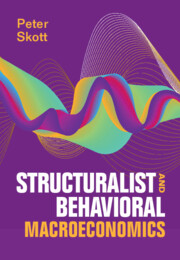Book contents
- Frontmatter
- Contents
- Figures
- Preface and Acknowledgments
- 1 Introduction: The State of Macroeconomics
- 2 The Lucas Critique and Representative Agents
- 3 Household Consumption and Saving
- 4 Saving in a Corporate Economy
- 5 Phillips Curves and the Natural Rate of Unemployment
- 6 Fairness, Money Illusion, and Path Dependency
- 7 Earnings Inequality, Power Bias, and Mismatch
- 8 Macroeconomic Adjustment and Keynes’s Instability Argument
- 9 Growth and Cycles
- 10 Endogenous Growth Cycles with or without Price Flexibility
- 11 Secular Stagnation and Functional Finance
- 12 Concluding Comments: Evidence-Based Macroeconomics and Economic Theory
- References
- Author Index
- Subject Index
10 - Endogenous Growth Cycles with or without Price Flexibility
Published online by Cambridge University Press: 10 November 2023
- Frontmatter
- Contents
- Figures
- Preface and Acknowledgments
- 1 Introduction: The State of Macroeconomics
- 2 The Lucas Critique and Representative Agents
- 3 Household Consumption and Saving
- 4 Saving in a Corporate Economy
- 5 Phillips Curves and the Natural Rate of Unemployment
- 6 Fairness, Money Illusion, and Path Dependency
- 7 Earnings Inequality, Power Bias, and Mismatch
- 8 Macroeconomic Adjustment and Keynes’s Instability Argument
- 9 Growth and Cycles
- 10 Endogenous Growth Cycles with or without Price Flexibility
- 11 Secular Stagnation and Functional Finance
- 12 Concluding Comments: Evidence-Based Macroeconomics and Economic Theory
- References
- Author Index
- Subject Index
Summary
The baseline model in this chapter combines destabilizing Keynesian-Harrodian mechanisms with feedback effects from the labor market to firms’ output and investment decisions. The aggregation of micro-level output and investment decisions is analyzed explicitly and, following a Keynes-Marshall tradition, prices and profit shares adjust to clear the goods market. The flex-price assumption is empirically motivated: evidence shows that goods prices are much more flexible than commonly believed. The model produces limit cycles around a locally unstable steady growth path. A variant of the model that may fit parts of the service sector takes output as perfectly flexible, while the real wage is fixed. The reduced-form relations and dynamic patterns of this variant are virtually identical to those of the flex-price model, suggesting that these reduced-form equations may be a good starting point for analyzing business cycles in the aggregate economy. Reinforcing this conclusion, simulations of an extended version that uses empirically plausible parameters and includes fiscal and monetary policy shows a remarkable correspondence to cyclical patterns for the US.
Keywords
- Type
- Chapter
- Information
- Structuralist and Behavioral Macroeconomics , pp. 256 - 298Publisher: Cambridge University PressPrint publication year: 2023

